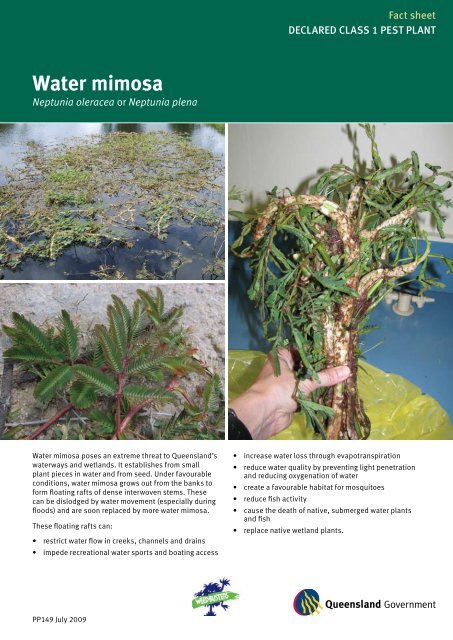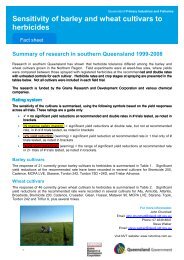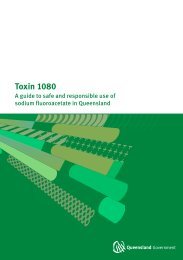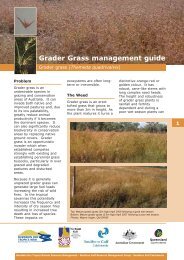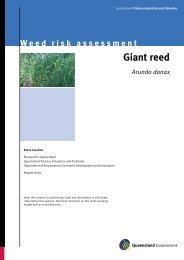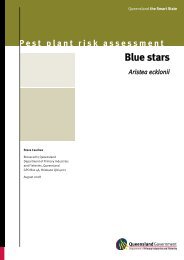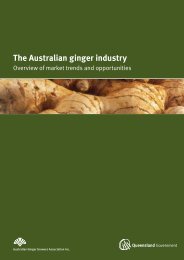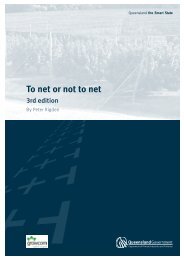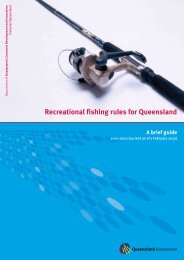Water mimosa fact sheet - Department of Primary Industries
Water mimosa fact sheet - Department of Primary Industries
Water mimosa fact sheet - Department of Primary Industries
Create successful ePaper yourself
Turn your PDF publications into a flip-book with our unique Google optimized e-Paper software.
<strong>Water</strong> <strong>mimosa</strong><br />
Neptunia oleracea or Neptunia plena<br />
<strong>Water</strong> <strong>mimosa</strong> poses an extreme threat to Queensland’s<br />
waterways and wetlands. It establishes from small<br />
plant pieces in water and from seed. Under favourable<br />
conditions, water <strong>mimosa</strong> grows out from the banks to<br />
form floating rafts <strong>of</strong> dense interwoven stems. These<br />
can be dislodged by water movement (especially during<br />
floods) and are soon replaced by more water <strong>mimosa</strong>.<br />
These floating rafts can:<br />
•<br />
•<br />
restrict water flow in creeks, channels and drains<br />
impede recreational water sports and boating access<br />
PP149 July 2009<br />
•<br />
•<br />
•<br />
•<br />
•<br />
•<br />
Fact <strong>sheet</strong><br />
DECLARED CLASS 1 PESt PLAnt<br />
increase water loss through evapotranspiration<br />
reduce water quality by preventing light penetration<br />
and reducing oxygenation <strong>of</strong> water<br />
create a favourable habitat for mosquitoes<br />
reduce fish activity<br />
cause the death <strong>of</strong> native, submerged water plants<br />
and fish<br />
replace native wetland plants.
PR09_4493<br />
© Bernard Loison www.mytho-fleurs.com<br />
Declaration details<br />
<strong>Water</strong> <strong>mimosa</strong> is a declared Class 1 plant under the Land<br />
Protection (Pest and Stock Route Management) Act 2002.<br />
Declaration requires landholders to keep their land free<br />
<strong>of</strong> Class 1 pests. It is a serious <strong>of</strong>fence to introduce,<br />
keep or sell Class 1 pests without a permit. A local<br />
government may serve a notice upon a landholder<br />
requiring control <strong>of</strong> declared pests.<br />
Description and general information<br />
Appearance<br />
<strong>Water</strong> <strong>mimosa</strong> is an aquatic floating perennial herb that<br />
attaches to the bank at the waters edge and sends down<br />
a taproot. Stems grow out over the water and form a<br />
spongy, fibrous covering between the nodes. Fibrous<br />
(adventitious) roots grow from the nodes. The rooted<br />
land form has smaller leaves and flowers, and has no<br />
spongy floating tissue.<br />
Leaves<br />
Leaves are olive green and are arranged in opposite<br />
pairs along the stem. When disturbed or touched the<br />
leaflets close up.<br />
Flowers<br />
<strong>Water</strong> <strong>mimosa</strong> flowers are yellow, ball-shaped and<br />
grow from the base <strong>of</strong> the leaves. Flowering begins in<br />
early summer.<br />
Life cycle<br />
<strong>Water</strong> <strong>mimosa</strong> can grow from seeds and from sections <strong>of</strong><br />
stem that break free from the parent plant.<br />
Habitat and distribution<br />
<strong>Water</strong> <strong>mimosa</strong> takes root on the banks <strong>of</strong> watercourses<br />
and grows out over the water surface, forming floating<br />
rafts. Within its native range, water <strong>mimosa</strong> is a<br />
common floating plant in freshwater pools, swamps<br />
and canals at low altitudes <strong>of</strong> up to 300 m. When water<br />
levels fall during the dry season, the plants <strong>of</strong>ten perish.<br />
The plants prefer slow-moving water 30–80 cm deep,<br />
full sun and hot, humid conditions. Shade, brackish<br />
water and saline soil adversely affect plant growth.<br />
Neptunia oleracea is accepted as being native to<br />
tropical Asia, Africa and South America. It grows wild<br />
and is cultivated as a vegetable throughout South-East<br />
Asia, particularly Thailand and Indo-China. Neptunia<br />
plena grows in the coastal regions <strong>of</strong> southern North<br />
America, Central America, northern South America and<br />
tropical Asia.<br />
Control<br />
There are no chemicals registered specifically for use<br />
against water <strong>mimosa</strong>. In most instances, the most<br />
appropriate method <strong>of</strong> control is to physically remove<br />
the infestation. This can be done by removing all plant<br />
matter from the infested water body and pulling plants<br />
out <strong>of</strong> the surrounding banks, ensuring removal <strong>of</strong> the<br />
attached root system. This should be repeated on a<br />
regular basis until regrowth ceases. All removed plant<br />
parts should then be disposed <strong>of</strong> in an appropriate<br />
waste facility or rubbish bin.<br />
Further information<br />
Further information is available from your local<br />
government <strong>of</strong>fice, or from your local primary industries<br />
and fisheries biosecurity <strong>of</strong>ficer: contact details are<br />
available through 13 25 23.<br />
Fact <strong>sheet</strong>s are available from Queensland <strong>Primary</strong> <strong>Industries</strong> and Fisheries service centres and the Queensland <strong>Primary</strong> <strong>Industries</strong> and Fisheries Business Information<br />
Centre (telephone 13 25 23). Check our website at www.dpi.qld.gov.au to ensure you have the latest version <strong>of</strong> this <strong>fact</strong> <strong>sheet</strong>. The control methods referred to in this pest<br />
<strong>fact</strong> should be used in accordance with the restrictions (federal and state legislation, and local government laws) directly or indirectly related to each control method.<br />
These restrictions may prevent the use <strong>of</strong> one or more <strong>of</strong> the methods referred to, depending on individual circumstances. While every care is taken to ensure the accuracy<br />
<strong>of</strong> this information, Queensland <strong>Primary</strong> <strong>Industries</strong> and Fisheries does not invite reliance upon it, nor accept responsibility for any loss or damage caused by actions<br />
based on it.<br />
© The State <strong>of</strong> Queensland, <strong>Department</strong> <strong>of</strong> Employment, Economic Development and Innovation, 2009.


